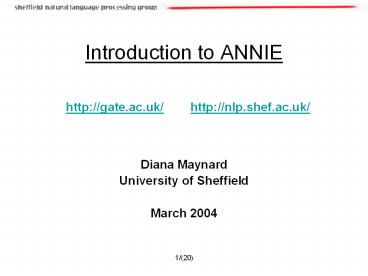Introduction to ANNIE - PowerPoint PPT Presentation
Title:
Introduction to ANNIE
Description:
Typically a new application will use most of the core components ... JAPE is a pattern-matching language. The LHS of each rule contains patterns to be matched ... – PowerPoint PPT presentation
Number of Views:212
Avg rating:3.0/5.0
Title: Introduction to ANNIE
1
Introduction to ANNIE
http//gate.ac.uk/ http//nlp.shef.ac.uk/
- Diana Maynard
- University of Sheffield
- March 2004
2
What is ANNIE?
- ANNIE is a vanilla information extraction system
comprising a set of core PRs - Tokeniser
- Sentence Splitter
- POS tagger
- Gazetteers
- Semantic tagger (JAPE transducer)
- Orthomatcher (orthographic coreference)
3
ANNIE Pipeline
4
Other Processing Resources
- There are also lots of additional processing
resources which are not part of ANNIE itself but
which come with the default installation of GATE - Gazetteer collector
- PRs for Machine Learning
- Various exporters
- Annotation set transfer
- etc.
5
Creating a new application from ANNIE
- Typically a new application will use most of the
core components from ANNIE - The tokeniser, sentence splitter and orthomatcher
are basically language, domain and
application-independent - The POS tagger is language dependent but domain
and application-independent - The gazetteer lists and JAPE grammars may act as
a starting point but will almost certainly need
to be modified - You may also require additional PRs (either
existing or new ones)
6
Modifying gazetteers
- Gazetteers are plain text files containing lists
of names - Each gazetteer set has an index file listing all
the lists, plus features of each list (majorType,
minorType and language) - Lists can be modified either internally using
Gaze, or externally in your favourite editor - Gazetteers can also be mapped to ontologies
- To use Gaze and the ontology editor, you need to
download the relevant creole files
7
JAPE grammars
- A semantic tagger consists of a set of rule-based
JAPE grammars run sequentially - JAPE is a pattern-matching language
- The LHS of each rule contains patterns to be
matched - The RHS contains details of annotations (and
optionally features) to be created - More complex rules can also be created
8
Input specifications
- The head of each grammar phase needs to contain
certain information - Phase name
- Inputs
- Matching style
- e.g.
- Phase location
- Input Token Lookup Number
- Control appelt
9
Matching algorithms and Rule Priority
- 3 styles of matching
- Brill (fire every rule that applies)
- First (shortest rule fires)
- Appelt (use of priorities)
- Appelt priority is applied in the following order
- Starting point of a pattern
- Longest pattern
- Explicit priority (default -1)
10
NE Rule in JAPE Rule Company1 Priority 25
( ( Token.orthography
upperInitial ) //from tokeniser
Lookup.kind companyDesignator //from
gazetteer lists )match --gt
match.NamedEntity kindcompany,
ruleCompany1
11
LHS of the rule
- LHS is expressed in terms of existing
annotations, and optionally features and their
values - Any annotation to be used must be included in the
input header - Any annotation not included in the input header
will be ignored (e.g. whitespace) - Each annotation is enclosed in curly braces
- Each pattern to be matched is enclosed in round
brackets and has a label attached
12
Macros
- Macros look like the LHS of a rule but have no
label - Macro NUMBER
- ((Digit))
- They are used in rules by enclosing the macro
name in round brackets - ( (NUMBER))match
- Conventional to name macros in uppercase letters
- Macros hold across an entire set of grammar phases
13
Contextual information
- Contextual information can be specified in the
same way, but has no label - Contextual information will be consumed by the
rule - (Annotation1)
- (Annotation2)match
- (Annotation3)
- ?
14
RHS of the rule
- LHS and RHS are separated by ?
- Label matches that on the LHS
- Annotation to be created follows the label
- (Annotation1)match
- ? match.NE feature1 value1, feature2
value2
15
Using phases
- Grammars usually consist of several phases, run
sequentially - Only one rule within a single phase can fire
- Temporary annotations may be created in early
phases and used as input for later phases - Annotations from earlier phases may need to be
combined or modified - A definition phase (conventionally called
main.jape) lists the phases to be used, in order - Only the definition phase needs to be loaded
16
More complex JAPE rules
- Any Java code can be used on the RHS of a rule
- This is useful for e.g. feature percolation,
ontology population, accessing information not
readily available, comparing feature values,
deleting existing annotations etc. - There are examples of these in the user guide and
in the ANNIE NE grammars - Most JAPE rules end up being complex!
17
Using JAPE for other tasks
- JAPE grammars are not just useful for NE
annotation - They can be a quick and easy way of performing
any kind of task where patterns can be easily
recognised and a finite-state approach is
possible, e.g. transforming one style of markup
into another, deriving features for the learning
algorithms
18
Example rule for deriving features
- Rule Entity( Gpe Organization
Person Location Facility - )entity--gtgate.AnnotationSet entityAS
- (gate.AnnotationSet)bindings.get("entity")
- gate.Annotation entityAnn (gate.Annotation)entit
yAS.iterator().next() - gate.FeatureMap features Factory.newFeatureMap()
- features.put("type", entityAnn.getType())outputA
S.add(entityAnn.getStartNode(),
entityAnn.getEndNode(), - "Entity, features)
19
Finding Examples
- ANNIE for default NE rules
- gate/src/gate/resources/creole/NEtransducer/NE/
- MUSE for more complex NE rules
- muse/src/muse/resources/grammar/main
- h-TechSight for ontology population
- htechsight/application/grammar
- Various other applications generally follow the
format - projectname/application/grammar/
20
Conclusion
- This talk http//gate.ac.uk/sale/talks/annie-tut
orial.ppt - More information http//gate.ac.uk/































